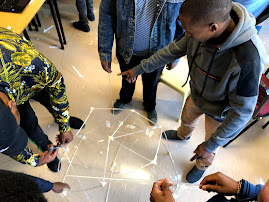Benefits of Unplugged Coding
- Karen Walstra
- Feb 1
- 3 min read
Updated: Feb 2

In June 2024 the new CAPS Foundation Phase (FP) Coding and Robotics Curriculum was made public. (FP curriculum). The majority of the coding activities in the Foundation Phase are unplugged coding activities. These activities can be used as an introduction to computational thinking and coding concepts. The Department of Basic Education has postponed the introduction of Foundation Phase coding and robotics for a year, schools teaching coding and robotics, have been told to continue.
The FP, Intermediate Phase and Senior Phase Coding and Robotics curricula have three

knowledge areas: "Coding", "Robotics" and "Digital concepts". Each knowledge area has high-level competencies (FP CAPS pg. 13). The same high-level competencies are used across the grades - Grade R to Grade 9.
The high-level competencies for coding are:
C1 Apply computational thinking skills to develop a set of logical instructions to solve a problem
C2 Present a simple coding solution using symbolic or written statements representing sequences of commands, single repetition and conditional constructs
C3 Interpret and execute a given symbolic or written set of commands
C4 Debug a given symbolic or written set of instructions
C5 Evaluate a given solution towards potential improvement
C6 Recognise and interpret patterns in symbolic sets of data and visualisations
C7 Create and complete pattern to represent a particular data set
The high-level competencies for the Coding knowledge area, are implemented in the ‘Pattern Recognition’ (PR) and ‘Algorithm Design and Coding’ (ADC) sections of the FP curriculum.
The table indicates which coding competencies are taught in each grade and section.
Gr. R:
| Gr. 1:
|
Gr. 2:
| Gr. 3:
|
Unplugged coding is a teaching methodology of the fundamentals of computer programming and computer science; the coding concepts; without using electronic devices like laptops, computers or tablets. Unplugged coding involves interactive activities, and hands-on exercises that help children grasp concepts of computational thinking, such as pattern recognition, decomposition, abstraction and algorithm design, and an introduction to coding concepts namely sequencing, loops, debugging and problem-solving. The unplugged coding activities are ways to teach the logic and problem-solving skills behind coding without using computers or digital devices. Tangible, hands-on teaching strategies such as games, movement, storytelling, and drawing to represent coding concepts.
The development of STEAM (science, technology. engineering, arts and mathematics) skills are highlighted as integral to teaching coding and robotics. STEAM is interdisciplinary across the coding and robotics knowledge areas. By engaging young learners in unplugged coding activities within a STEAM/STEM framework, teachers can spark their curiosity, develop their problem-solving abilities, and prepare them for the technological world they live in.

Unplugged coding offers numerous benefits for young children, making it a valuable tool for early learning.
Let's explore:
Develops Foundational and Core Skills: Unplugged coding activities foster essential skills such as problem-solving, critical thinking, logical reasoning, sequencing, and pattern recognition. These skills are essential for coding, academic success and everyday life.

Enhances Creativity and Imagination: Unplugged coding encourages children to think outside the box and express their ideas creatively. They learn to break down problems into smaller, manageable steps and find innovative solutions.
Builds Confidence and Collaboration: Working on unplugged coding activities together develops teamwork and communication skills. Children learn to share ideas, listen to others, compromise and learn to make joint decisions. This also builds the children's confidence in their abilities.
Access to Coding for All: Unplugged coding removes the need for expensive technology, making coding education accessible to all children regardless of their socioeconomic background.

Makes Coding Concepts Tactile: By using physical objects and activities, unplugged coding helps children understand abstract computational thinking and coding concepts in a concrete, tangible and hands-on way.
Sparks Interest in STEAM: Early exposure to coding through unplugged activities can ignite a lifelong passion for STEM/STEAM fields, opening up future opportunities in technology and related fields. Coding and robotics naturally fit within the STEM/STEAM framework as they involve aspects of all these disciplines.

Moving onto introductory robots such as the robot mouse, can be used to reinforce the unplugged computational thinking skills.
Beginning with unplugged coding builds confidence to move into coding and programming to teach learners.
mBot programmed using the mBlock code
Overall, unplugged coding provides a fun and engaging way for young children to develop essential skills while laying a strong foundation for future learning in technology and other areas.
As a FP teacher, explore unplugged activities and empower your learners.
Upskill yourself, and build your coding confidence. Have fun!


Interested in PD sessions, explore the courses tab.
Reach out to Dr. Karen Walstra






























Commentaires